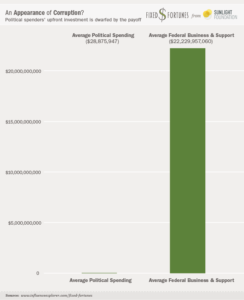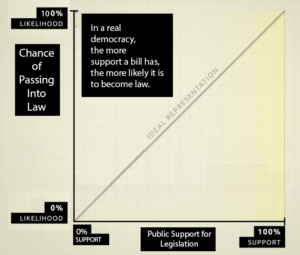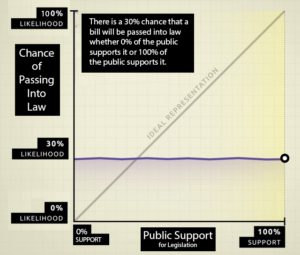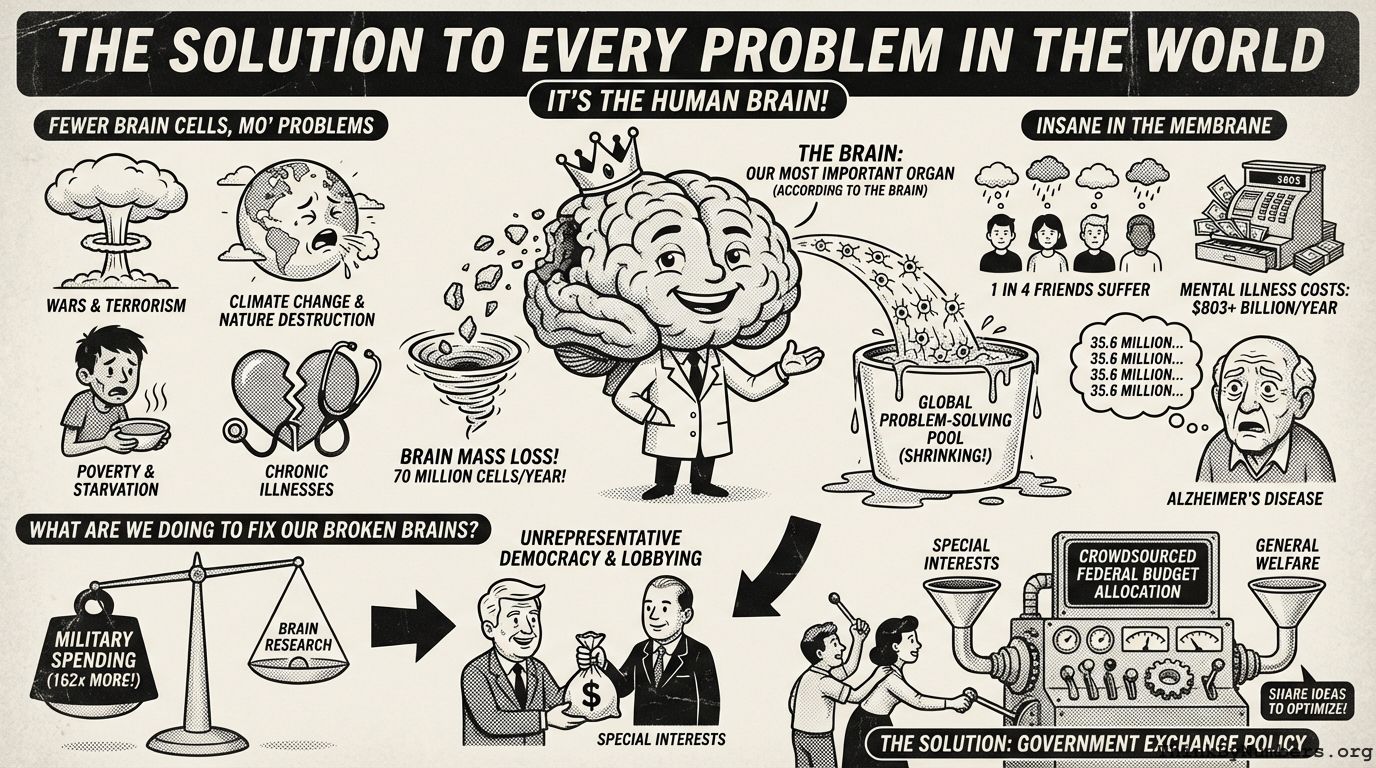Guess what holds the solution to every problem in the world? It's the human brain!
The brain is the most important organ in the body, according to the brain. Other organs disagree, but they don't get to write articles.
Your brain is dying.
After age 20, you lose about a gram of brain mass or 70 million brain cells every year! Multiply that by the 7.7 billion people in the world, and it comes out to 54,000,000,000,000,000 brain cells lost every year. That’s a pretty big number! So to put that in perspective, just imagine one brain cell 54,000,000,000,000,000 times. 😋
Fewer Brain Cells, Mo’ Problems
This natural brain rotting means we have 54 quadrillion fewer brain cells to solve problems like:
- Cancer, aids, cystic fibrosis, heart disease, and other chronic illnesses
- Climate change and the destruction of nature
- Wars and terrorism
- Poverty, starvation, and unemployment
- Government corruption
On top of the fact that your brain is naturally rotting, brain diseases also impose massive costs on the economy.
Insane in the Membrane
3 people will have killed themselves in the time it takes to read this article. (Hopefully, not as a result of reading this article.)
1 in 4 of your friends and loved ones are suffering from a mental illness like depression, bipolar disorder, or schizophrenia. It’s also expensive as hell. Here’s your bill for the year:
- Direct Medical Costs = $150 Billion
- Incarceration of the Mentally Ill = $35 Billion
- Social Services for the Mentally Ill = $150 Billion
- Lost Productivity and Absenteeism = $468 Billion
That all comes out to $803,346,862,554.63. Don’t forget to tip your server.
Also, I forgot to mention the 800,000 people that will commit suicide this year, further reducing our global problem-solving brain cell pool by 80,000,000,000,000,000 brain cells.
Alzheimer’s Disease
Alzheimer’s disease is the leading cause of unsubstantiated claims that nurses stealing your jewelry and trying to poison you.
The Magnitude of Alzheimer’s Disease
- 35.6 million people suffer from Alzheimer’s disease.
- Also, 35.6 million people suffer from Alzheimer’s disease.
- Also, have I ever told you about how 35.6 million people suffer from Alzheimer’s disease?
This 35.6 million will very likely include you or a parent or grandparent at some point.
The Financial Cost of Alzheimer’s Disease
$604 billion per year including:
- medical costs
- the cost of formal
- informal care
What are we doing to fix our broken brains?
So, as you can see, we’re spending trillions of dollars dealing with the consequences of our flawed or malfunctioning minds. One would think that we’re making similar efforts to prevent or find solutions to the root causes of these neurological failures.
Wrong!
Disproportionate Resource Allocation
This is just one of many examples of the reason why our neurological problems keep getting worse every year instead of better.
There’s a 1 in 20,000,000 chance you’ll be killed in a terrorist attack.
There’s a 1 in 10 chance you will die with Alzheimer’s disease.
However, we spend 162 times more on the military than brain research in order to prevent a threat that’s 2 million times less likely to affect you.

Obviously, a single death from terrorism is too many. However, we do not have infinite resources. We simply have to do a cost-benefit analysis and allocate our limited resources in proportion to the threat if we actually want to reduce suffering in the world.
Protect and Promote the General Welfare
The official purpose of government is to promote and protect the general welfare. Unfortunately, in reality, the government very often does the exact opposite. It reduces the general welfare by taxing the general public and funneling their wealth to special interests and corporations large enough and immoral enough to hire lobbyists. So its actual function is to promote and protect the specific welfare of these special interests and only the most wealthy and greedy fraction of corporations.
The Primary Cause of Disproportionate Spending: Lobbying
For every single member of Congress, there are more than 23 lobbyists whose full-time job is to badger that single congressperson into giving some corporation or special interest organization money through sweetheart contracts or subsidies.

It’s only rational for special interests to make this investment. For every dollar spent on influencing politics, the nation’s most politically active corporations received $760 from the government. That’s an average 76,000% return on investment compared to the 11% you’ll get from the stock market.


Unrepresentative Democracy
The result of this is nothing less than the complete transfer of power from the citizenry to special interests. In a truly representative democracy, the more public support there is for a policy, the more likely it would be to become law.

However, in reality, public support has almost no influence on what laws are passed. Whether there is 0% or 100% support for a policy, there’s a 30% likelihood that it will become law.

The Solution: A Government Exchange Policy
Buckminster Fuller said that when trying to change something, instead of going up against it, create something new that makes the problem obsolete. The solution is to have the government issue everyone a receipt with an exchange policy.
Every citizen should have access to a shopping cart showing what their share of public resources will be spent on. They should have the ability to adjust their allocation as they see fit.
It’s important to recognize that our resources are finite, so it’s good to have an increase in one area automatically decrease resources in another area. Here’s a crude prototype that you’re welcome to fork and improve:
[codepen_embed height=”432.5″ default_tab=”html,result” slug_hash=”xygVog” user=”mikepsinn”]See the Pen
Crowdsourced Federal Budget Allocation by Mike P. Sinn (@mikepsinn)
on CodePen.[/codepen_embed]
Do you have any ideas about how to optimize societal resource allocation? Please share them in the comments!



Comments